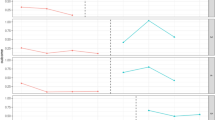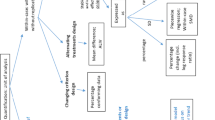Abstract
Single-case designs (also called single-case experimental designs) are system of research design strategies that can provide strong evidence of intervention effectiveness by using repeated measurement to establish each participant (or case) as his or her own control. The flexibility of the designs, and the focus on the individual as the unit of measurement, has led to an increased interest in the use of single-case design research in many areas of intervention research. The purpose of this chapter is to introduce the reader to the basic logic underlying the conduct and analysis of single-case design research by describing the fundamental features of this type of research, providing examples of several commonly used designs, and reviewing the guidelines for the visual analysis of single-case study data. Additionally, current areas of consensus and disagreement in the field of single-case design research will be discussed.
Similar content being viewed by others
References
Ahearn WH, Kerwin ML, Eicher PS, Shantz J, Swearingin W. An alternating treatments comparison of two intensive interventions for food refusal. J Appl Behav Anal. 1996:29(3):321–32.
Allison DB, Franklin RD, Heshka S. Reflections on visual inspection, response guided experimentation, and type I error rate in single-case designs. J Exp Educ. 1992;61(1):45–51.
Baer DM. Perhaps it would be better not to know everything. J Appl Behav Anal. 1977;10:167–72.
Baer DM, Wolf MM, Risley TR. Some current dimensions of applied behavior analysis. J Appl Behav Anal. 1968;1:91–7.
Barlow DH, Hayes SC. Alternating treatments design: one strategy for comparing the effects of two treatments in a single subject. J Appl Behav Anal. 1979;12(2):199–210.
Barlow DH, Nock M, Hersen M. Single-case experimental designs. 3rd ed. 2009.
Barrish HH, Saunders M, Wolf MM. Good behavior game: effects of individual contingencies for group consequences on disruptive behavior in a classroom. J Appl Behav Anal. 1969;2:119–24.
Brownell KD, Stunkard AJ, Albaum JM. Evaluation and modification of exercise patterns in the natural environment. Am J Psychiatr. 1980;137:1540–5.
Byun TM, Hitchcock ER, Ferron J. Masked visual analysis: minimizing type I error in visually guided single-case design for communication disorder. J Speech Lang Hear Res. 2017;60: 1455–66.
Colvin G, Sugai G, Good RJ, Lee YY. Using active supervision and pre-correction to improve transition behaviors in an elementary school. Sch Psychol Q. 1997;12:344–63.
Dallery J, Cassidy RN, Raiff BR. Single-case experimental designs to evaluate novel technology-based health interventions. J Med Internet Res. 2013;15:e22.
Dugard P, File P, Todman J. Single-case and small-n experimental designs: a practical guide to randomization tests. New York: Routledge; 2012.
Ferron J, Ware W. Using randomization tests with responsive single-case designs. Behav Res Ther. 1994;32:787–91.
Fisch GS. Evaluating data from behavioral analysis: visual inspection or statistical models? Behav Process. 2001;54:137–54.
Gast DL, Ledford J. Single case research methodology. 2nd ed. New York: Routledge; 2014.
Hersen M, Bellack AS. A multiple-baseline analysis of social-skills training in chronic schizophrenics. J Appl Behav Anal. 1976;9(3):239–45.
Higgins Hains AH, Baer DM. Interaction effects in multielement designs: inevitable, desirable, and ignorable. J Appl Behav Anal. 1989;22:57–69.
Horner RD, Baer DM. Multiple-probe technique: a variation of the multiple baseline. J Appl Behav Anal. 1978;11:189–96.
Horner RH, Carr EG, Halle J, McGee G, Odom S, Wolery M. The use of single subject research to identify evidence-based practice in special education. Except Child. 2005;71:165–79.
Horner RH, Swaminathan H, Sugai G, Smolkowski K. Considerations for the systematic analysis and use of single-case research. Educ Treat Child. 2012;35(2):269–90.
Jones RR, Weinrott MR, Vaught RS. Effects of serial dependency on the agreement between visual and statistical inference. J Appl Behav Anal. 1978;11:277–83.
Kazdin AE. Single-case experimental designs: methods for clinical and applied settings. New York: Oxford University Press; 1982.
Kazdin AE. Single-case research designs: methods for clinical and applied settings. New York: Oxford University Press; 2011.
Kratochwill TR, Hitchcock J, Horner RH, Levin JR, Odom SL, Rindskopf DM, Shadish WR. Single-case designs technical documentation. 2010. Retrieved from What Works Clearinghouse website: http://ies.ed.gov/ncee/wwc/pdf/wwc_scd.pdf.
Kratochwill TR, Levin JR. Enhancing the scientific credibility of single-case intervention research: randomization to the rescue. In: Kratochwill TR, Levin JR, editors. Single-case intervention research: methodological and statistical advances. Washington, DC: American Psychological Association; 2014. p. 53–90.
Ledford JR, Gast DL. Measuring procedural fidelity in behavioural research. Neuropsychol Rehabil. 2014;24:332–48.
Manolov R, Gast DL, Perdices M, Evans JJ. Single-case experimental designs: reflections on conduct and analysis. Neuropsychol Rehabil. 2014;24(3–4):634.
Matyas TA, Greenwood KM. Visual analysis of single-case time series: effects of variability, serial dependence, and magnitude of intervention effects. J Appl Behav Anal. 1990;23:341–51.
Morgan DL, Morgan RK. Comparing group and single-case designs. In: Morgan DL, Morgan RK, editors. Single-case research methods for the behavioral and health sciences. Thousand Oaks: SAGE; 2014.
Parsonson BS, Baer DM. The analysis and presentation of graphic data. In: Kratochwill T, editor. Single subject research. New York: Academic; 1978. p. 101–66.
Parsonson BS, Baer DM. The visual analysis of data, and current research into stimuli controlling it. In: Kratochwill TR, Levin JR, editors. Single-case research design and analysis: new directions for psychology and education. Hillsdale: Lawrence Erlbaum Associates; 1992. p. 15–40.
Putnam RF, Handler MW, Ramirez-Platt CM, Luiselli JK. Improving student bus-riding behavior through a whole-school intervention. J Appl Behav Anal. 2003;36:583–90.
Rose M. Single-subject experimental designs in health research. In: Liamputtong P, editor. Research methods in health: foundations for evidence-based practice. Melbourne: Oxford University Press; 2017. p. 217–34.
Schlosser RW, Blischak DM. Effects of speech and print feedback on spelling by children with autism. J Speech Lang Hear Res. 2004;47(4):848.
Shadish WR, Cook TD, Campbell DT. Experimental and quasi-experimental designs for generalized causal inference. Boston: Houghton Mifflin; 2002.
Sidman M. Tactics of scientific research. Boston: Authors Cooperative, Inc; 1960.
Sindelar P, Rosenberg M, Wilson R. An adapted alternating treatments design for instructional research. Educ Treat Child. 1985;8(1):67–76.
Smith JD. Single-case experimental designs: a systematic review of published research and current standards. Psychol Methods. 2012;17:510–50.
Stark LJ, Bowen AM, Tyc VL, Evans S, Passero MA. A behavioral approach to increasing calorie consumption in children with cystic fibrosis. J Pediatr Psychol. 1990;15:309–26.
Wolery M. Procedural fidelity: a reminder of its functions. J Behav Educ. 1994;4:381–6.
Author information
Authors and Affiliations
Corresponding author
Editor information
Editors and Affiliations
Rights and permissions
Copyright information
© 2018 Springer Nature Singapore Pte Ltd.
About this entry
Cite this entry
Byiers, B. (2018). Single-Case Designs. In: Liamputtong, P. (eds) Handbook of Research Methods in Health Social Sciences . Springer, Singapore. https://doi.org/10.1007/978-981-10-2779-6_92-1
Download citation
DOI: https://doi.org/10.1007/978-981-10-2779-6_92-1
Received:
Accepted:
Published:
Publisher Name: Springer, Singapore
Print ISBN: 978-981-10-2779-6
Online ISBN: 978-981-10-2779-6
eBook Packages: Springer Reference Social SciencesReference Module Humanities and Social SciencesReference Module Business, Economics and Social Sciences




